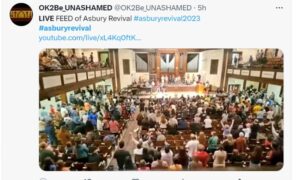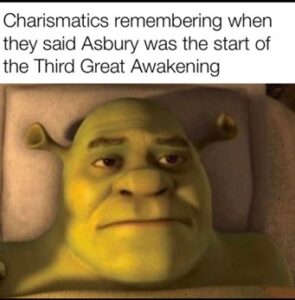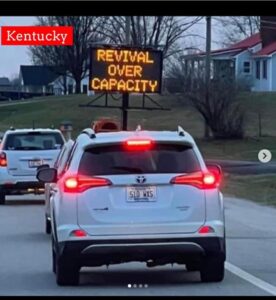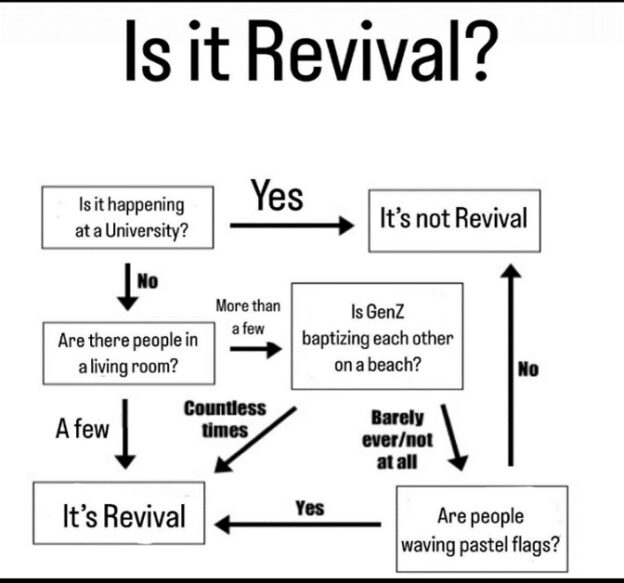By Laura Hall
On the 8th of February 2023 imagery connected to the hashtag #asburyrevival started trending across social media platforms. Revivalism is intrinsic to evangelical varieties of Christianity and ‘outpourings of the Holy Spirit’ as (innumerable) testimonies, in the form of multimedia video clips in the evolving digital archive attest to, are feature of Pentecostal/Charismatic movements. Revivals, specifically at Asbury, a Methodist College in the Wesleyan Holiness tradition have previously occurred in 1905, 1908, 1950 and the 1970’s. At the time of writing, Asbury ‘23 is still ongoing; it has been displaced from its original location when the town of Wilmore was overwhelmed by hundreds of thousands of curious visitors taking selfies. Connected (#asburyawakening) revivals have broken out in a number of other locations, comparisons drawn with the ‘Toronto Blessing’ of the 1990’s, and similar events. Where Asbury ’23 differs, is in the prolific use of social media to ‘authorise’ and ‘authenticate’ (or disauthenticate) a Christian practice (a ‘revival’) visually: by means of imagery.
The global circulation of images, connected via digital objects such as hashtags (a textual inclusion) or emojis, is a feature of the shift from the ‘new’ media of the early 2000’s (‘Web 2.0’), to what Lev Manovich refers to as the age of ‘more media’ (2020)—the proliferation of social media platforms where visuality is the key mode of communication, such as Instagram (launched 2010) or TikTok (2016). The networking of imagery, (such as the Iranian protests over compulsory hijab wearing, or clips of the moment climate activists threw soup over Van Gogh’s Sunflowers in some recent examples), are a feature of our ‘more media’ world. Whilst the imagery associated with the revival at Asbury is not quite as provocative, the principal is the same.

Figure 1. Google Image Search. Searching Images sources and web locations. Left: Asbury Revival 1970 juxtaposed with Asbury Revival 2023. Right visual matches located by the algorithm.
An ‘event’, in this case a revival at Asbury College in Wilmore, Kentucky, sparked an image reaction: the networking of images on a scale that was global (I traced reactions from Nigeria and South Korea amongst other locations), and simultaneous with a number of ‘citizen journalists’ and participants providing live streaming for a seemingly affective worldwide virtual audience. Social media users annotated the images by commenting, either positively or negatively, liking, tagging, altering, and recirculating them, (a user-generated classification system called a ‘folksonomy’), and platforms provided time/date stamps; an opportunity, as Niederer & Colombo (2019) describe, for ‘knowledge co-production’.

Figure 2. Example of one of many livestreams of #asburyrevival shared via Twitter
Digitized images of newspaper clippings and photographs from earlier revivals coalesced with ‘born digital’ imagery from the contemporary event; a technique referred to as ‘historiographical metapicturing’ (Rogers 2021). The technological affordances across platforms, (TikToks on Twitter and YouTube via Instagram) created a ‘swarm logic’: each platform has its own vernacular to recommend and rank images in distinctive ways but, in principle, the algorithms promote the images that have been most engaged with, and on it goes. The Asbury revival ‘23 crossed from social into mainstream media, adding another layer of imagery incorporated into the mix. Geotagging enabled those not physically at Asbury to be ‘at Asbury’, metaphorically speaking, and the archive grew yet again as people added their own reminiscences, tagged to the geographic location.
In contrast to approaches that consider images as data and focus on content, visual methodologies for social media research draws from the fields of Art History and Visual Studies to ask how, and what would it mean, to study collections of images as they are encountered and collected online and what if those collections contain billions of images? The number of images uploaded to Flicker per week is greater than all objects in art galleries in the world, Manovich claims, and 2 billion images are added to Instagram alone daily. Richard Rogers (2022) argues that memes should be regarded as a genre in their own right, and I clocked Asbury memes appearing around 7 days into the revival.

Figure 3. Meme related to #asburyrevival via Instagram
Applying visual methodologies offers the opportunity to combine quantitative analysis (zoom out: looking at patterns, ‘circulationism’, repetition, and modification, encountering stability and instability, or disruptions in the collection) with qualitative analysis (zoom in) for close engagement with specific imagery and image practices. Looking at image collections affords consideration of the visual practices specific to digital cultures, which is my interest—the visual practices and aesthetics associated with ‘digital Pentecostalism’ (Cartledge 2022). Rather than considering digital imagery as ephemera, we should be investigating the ‘materiality’, the techniques and the aesthetics to understand the effects this has on religion/s now, which is what I am doing in my research.

Figure 4. The revival reaches capacity.
References
Cartledge, Mark (2022) Studying Digital Pentecostalism: Empirical-Theological Hermeneutics, Ethnography, and the Internet. Pneuma, Brill.
Klaver, Miranda (2023) https://www.theologie.nl/artikelen/de-asbury-revival/
Keener, Craig (2023) http://pneumareview.com/people-met-jesus-deeply-here-craig-keener-on-the-asbury-outpouring/
Manovich, Lev (2022) Cultural Analytics http://manovich.net/index.php/projects/tag:Book
Niederer & Colombo (2019) Visual Methodologies for Networked Images: Designing Visualizations for Collaborative Research, Cross Platform Analysis and Public Participation. https://revistadisena.uc.cl/index.php/Disena/article/view/151/905
Rogers, Richard (2021) Visual Media Analysis for Instagram and Other Online Platforms https://journals.sagepub.com/doi/10.1177/20539517211022370
Rogers, Richard et al. (2022) What is a meme, technically speaking? https://wiki.digitalmethods.net/Dmi/WinterSchool2022WhatIsAMeme

